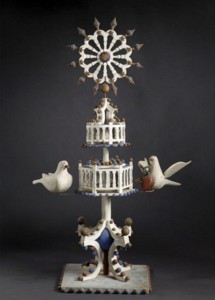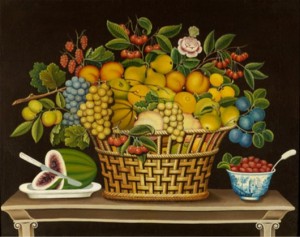KANSAS CITY, Mo. – A stunning presentation of American folk art made primarily in rural areas of New England, the Midwest and the South between 1800 and 1925 opens at The Nelson-Atkins Museum of Art in Kansas City March 28. A Shared Legacy: Folk Art in America celebrates art rooted in personal and cultural identity and made by self-taught or minimally trained artists and artisans.
Drawn from the prestigious collection of Barbara L. Gordon, A Shared Legacy highlights 63 outstanding examples of American folk art. Vivid portraits, still lifes, and landscapes, as well as distinctive examples of painted furniture from the German American community, carved boxes, sculpture and decorative arts of the highest quality offer an introduction to more than a century of America’s rich and diverse folk art traditions and exemplify the breadth of American creative expression.
“We are immensely grateful to Barbara Gordon for sharing these remarkable works from her collection,” said Julián Zugazagoitia, Menefee D. and Mary Louise Blackwell CEO & Director of the Nelson-Atkins. “The appreciation of A Shared Legacy provides a path to our visitors seeing the importance of folk traditions and their significant conversation with academic art in our own collection.”
These works did not always adhere to the academic models that established artistic taste in urban centers of the East Coast. Yet, because of the large number of professional and amateur artists who created folk art in the years following the Nation’s founding — and the sheer quantity of art they produced — folk art was the prevalent art form in the United States for more than a century. A Shared Legacy was organized by Art Services International of Alexandria, Virginia, and debuted at the American Folk Art Museum in New York in Dec. 2014. When the exhibition closes in Kansas City July 5, it moves to the Memphis Brooks Museum of Art, and continues in various cities in 2016 and 2017.
“From engaging portraits and painted chests made to enhance the home to towering trade figures and even a carousel elephant that occupied commercial and recreational spheres, the collection of American folk art brought together and shared by Barbara Gordon not only highlights diverse artistic and aesthetic traditions, but rich personal, community, and cultural traditions as well. In that powerful way, the collection continues to resonate today,” said Stephanie Fox Knappe, Samuel Sosland Curator of American Art at the Nelson-Atkins.
A Shared Legacy provides an opportunity to examine both the aesthetics and meaning in a large body of American art and American life.
“Folk art speaks to the eye and the heart,” said Gordon. “For me, folk art represents the quintessential American art, growing indigenously out of the American experience. American folk art tells the story of our country in vivid colors, shapes, and forms. The paintings document individuals, places, and memories. The decorated furniture and domestic items, that brought color and style to a home, tell the story of daily life. Wood carvings, like cigar store figures, trade signs, and carousel animals, tell stories of commerce and recreation in earlier times.”
American folk art has a rich past. In the years immediately following the end of the Revolutionary War, Americans started leaving the places where their families had been rooted to explore new lands being opened to settlement. Government policy, coupled with the number of immigrants who sought to settle tribal lands, eventually increased the size of the United States and altered the natural landscape. Settlers brought with them the social and political organization and customs from their Eastern towns to create a comforting sense of continuity. As the outposts of settlement in the Northwest Territory grew, many assumed the appearance of New England villages. Distinctive cultural practices — the houses they built, the foods they ate, and the farming practices they employed — recreated the lives they had known in the East.
Art was another need to be met. Rooted in the family as well as the preservation of personal and cultural identity, art was one means by which Americans living far from their places of origin maintained a bond to the lives they had known. As communities were established and became prosperous, many people sought tangible evidence of their success. In Eastern cities, the well-to-do patronized trained artists who had studied at home or abroad. However, to meet the demand of customers who were living far from urban centers, self-taught or minimally-trained artists arose to create art for customers or for their own pleasure. A need for art in outlying areas fostered the emergence of several generations of artists who were responsible for a pivotal development in the history of American art.
“We are excited to present the first exhibition of American folk art to be held at the Nelson-Atkins in the last 20 years,” said Catherine Futter, Louis L. and Adelaide C. Ward Senior Curator of European Arts. “When the museum’s collection was formed in the late 1920s and early 1930s, American folk art played an important part in displaying the world’s, especially American, art and culture. The exhibition of Barbara Gordon’s collection is also an opportunity for the museum to display highlights from the museum’s holdings of American folk art.”
A complementary installation, American Folk Art from the Collection of The Nelson-Atkins Museum of Art, is on view through Nov. 1 in gallery 214. This exhibition includes portraits, landscapes, and samplers, from about 1784 to 1953, and even a cow weathervane. Many of the objects were collected by Kansas Citians in the 1930s and 1940s.
A Shared Legacy is accompanied by a full-color catalogue co-published by ASI and the international publishing firm SKIRA/Rizzoli.
Visit the Nelson-Atkins Museum of Art online at www.nelson-atkins.org .





